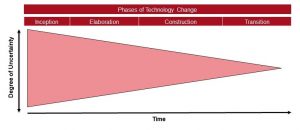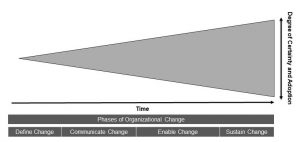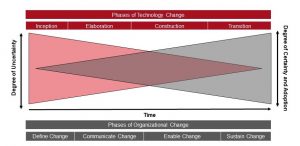“How will the change affect me personally?” This is the first question that people want answered as soon as they learn about upcoming plans for a large organizational change. However, at the early stages of preparing for organizational change, leaders are not able to give specific answers to these questions. This concept, known as the Cone of Uncertainty, is found in many industries including software development, project management, construction and risk management.
To a software development team, the Cone of Uncertainty describes how the amount of uncertainty evolves over time as the team moves through their phases of technology change. These activities include gathering business requirements in the Inception phase and creating a baseline functional and user interface and technical architecture in the Elaboration phase. In the Construction phase, a fully functioning solution is developed and delivered and data is migrated in the Transition phase.
As the chart illustrates below, the level of uncertainty decreases as the team gathers research and makes decisions through each phase. From a project management perspective, the Cone of Uncertainty illustrates the challenge to accurately estimate and manage the project when estimates at the beginning of the project can be a factor of 4x both on the high and low side of the actual effort required.

For leaders who are responsible to lead their organizations through change, an understanding of the Cone of Uncertainty is extremely important. When leaders announce a new vision and strategic direction that requires significant change, they must have a clear vision of the desired future state. However, details on how groups and individuals will get there, the exact timeline, and financial and people resources required are less clear. As a result, people start to feel anxious, get distracted by all the unknowns, and become less productive as they wait for the fog of uncertainty to clear.
To address these normal and expected reactions to change, leaders can take specific actions to mitigate the high uncertainty and guide people through the Cone of Certainty and Adoption© to increase readiness for the change. This cone is a mirror image of the Cone of Uncertainty, but increases at the same time that the Cone of Uncertainty decreases. Actions that help people’s certainty begin to evolve include senior leaders answering the question of “why change – why now” during the Define Change phase. During the Communicate Change phase, leaders engage with employees to discuss the “who, what, and when” so that as high-level plans are brought down to the local level, leaders identify specific training and communication needs. This information allows leaders to determine the “how” and details about how the change can be communicated through a variety of channels and mediums during the Enable Change phase. After the change is launched, leaders take actions in the Sustain Change phase to ensure certainty for the change reaches the maximum level. This happens as leaders support people in their new processes, tools, and behaviors while monitoring key metrics and ensuring the changes are adopted, reinforced, and become woven into the culture of the organization. The chart below illustrates how following these activities help increase certainty and adoption as people move through the phases of organizational change.
When we bring both charts together below, we see the obvious overlap and increase of each cone as opposite cone decreases through the phases of two types of change. However, decreasing the size of the Cone of Uncertainty based on a change in technology is relatively easier and more predictable than moving people through the Cone of Certainty and Adoption© for an organizational change. This is true regardless of a change from a merger, new business strategy, or new technology platform. Unlike computer hardware and software, people do not automatically move through these phases – but instead take steps of progress when they feel psychologically safe and supported.
As a result, leaders need to give equal – if not more attention – to specific actions they will take to help people through the phases of organizational change so that decreases in the degrees of certainty and adoption happen at a planned and steady pace. Often, people involved in planning and carrying out the technology change are also impacted. This underscores the need for leaders to engage with and involve these groups in the planning and activities to carry out the organizational change. By taking these actions at the beginning of your organization change initiative, people will be more aware of the big picture and the purpose of the change, more understanding of the timing when more details on how the change will impacted them personally, and more supportive as they are engaged in the planning and adoption of the change.




Great article. We are currently going through major changes in our organization and it is a bit challenging to go through with it. Changing the way people have worked for decades, we expected to get push backs but not this much.
Ivan, thanks for your comment. I’m glad the article was helpful. Resistance to change is a normal and natural response to change and introducing changes to long-held ways that people work requires extra planning and support. Is your change centered around new technology and processes? Is the push back coming from managers at the middle or from front line employees? If you can share some additional information, I may be able to provide some ideas that can help you.
Mike